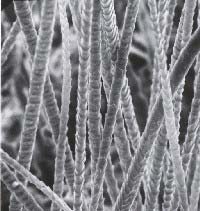Articles and reports from the Life Sciences and chemistry area deal with applied and basic research into modern biology, chemistry and human medicine.
Valuable information can be found on a range of life sciences fields including bacteriology, biochemistry, bionics, bioinformatics, biophysics, biotechnology, genetics, geobotany, human biology, marine biology, microbiology, molecular biology, cellular biology, zoology, bioinorganic chemistry, microchemistry and environmental chemistry.
A First Step Toward Robots the Size of a Grain of Sand
Chemists at the University of California, San Diego have developed minute grains of silicon that spontaneously assemble, orient and sense their local environment, a first step toward the development of robots the size of sand grains that could be used in medicine, bioterrorism surveillance and pollution monitoring.
In a paper to be published in September in the Proceedings of the National Academy of Sciences, which will

What can bees teach us about speed shopping?
Does trading off speed for accuracy pay?
“Bumblebees have been shown to have very fine colour vision – which they can use to find up to 5,000 flowers a day,” says says Melbourne scientist Adrian Dyer who first made the observations whilst working in Germany.
Adrian’s study published in Nature casts light on how they do it – and may help us to learn from the bees how to design robot eyes in the future.
Adrian is

Group of compounds found in red wine, vegetables simulate benefit of low-calorie diet
Mice, rats, worms, flies, and yeast all live longer on a low-calorie diet, which also seems to protect mammals against cancer and other aging-related diseases. Now, in yeast cells, researchers at Harvard Medical School and BIOMOL Research Laboratories have for the first time found a way to duplicate the benefits of restricted calories in yeast with a group of compounds found in red wine and vegetable

Anyone who made it to high school biology has learned about mitosis, or cell division. One cell divides into two, two into four and so forth in a process designed to pass on exact copies of the DNA in chromosomes to daughter cells. New research, by a University of Georgia team, shows how the genes that control this process are regulated.
The study is important for cancer research because the regulation of cell division goes awry in tumors and normal cell growth and behavior are lost. Unders

A group of scientists led by Dr. Elaine Fuchs at the Howard Hughes Medical Institute at the Rockefeller University have uncovered an unexpected new role for the well-known transcription factor, GATA-3, in hair follicle development. GATA-3 was previously identified for its role in coaxing hematopoietic stem cells towards a T-cell fate. Now, Dr. Fuchs and colleagues reveal that GATA-3 is also involved in epidermal stem cell specification. This finding lends valuable insight into hair follicle generatio

The process by which a cell reads the genetic code in its DNA in order to manufacture a protein is complex, involving dozens of enzymes and other biological molecules working together.
Now, research at Cornell University, using the fruit fly as a model system, has confirmed a theory about one step in the process by showing that a protein complex known as FACT is positioned in living cells at sites where chromosomal DNA is unpacked so that its code can be read. It is part of what the resear